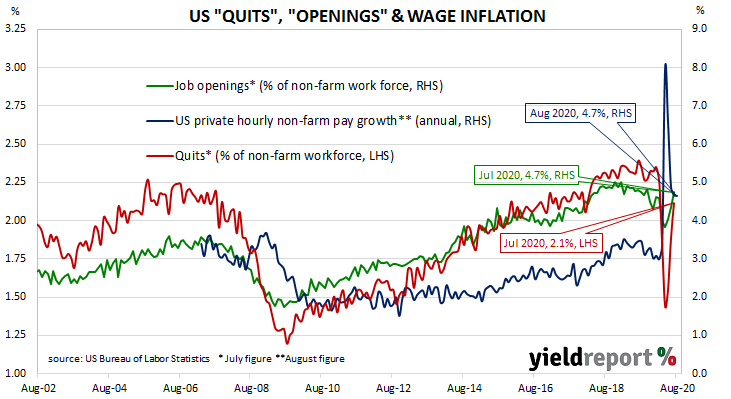Summary: US quit rate increases for third consecutive month; job openings also up; total separations up; retail trade sector significant in each categories; report consistent with improvement in other labour market indicators.
The number of US employees who quit their jobs as a percentage of total employment increased slowly but steadily after the GFC. It peaked in March 2019 and then tracked sideways until virus containment measures were introduced in March 2020. Quit rates plummeted as alternative employment opportunities rapidly dried up. However, a rapid recovery seems to have taken place.
Figures released as part of the most recent JOLTS report show the quit rate continued to stage a recovery. 2.1% of the non-farm workforce left their jobs voluntarily in July, a rise from June’s comparable figure of 1.9%. The largest source of additional quits arose from the “Retail trade” and “Professional and business services” sectors while the three sectors which experienced fewer quits did so only in small amounts. Overall, the total number of quits for the month increased from June’s figure of 2.605 million to 2.949 million in July.

April’s non-farm payroll report indicated average hourly pay had spiked, possibly the result of fewer lower-paid jobs relative to higher paying ones. Subsequent months’ figures then saw falls in average hourly pay, with a corresponding fall in the annual growth rate from 8.0% in April to 4.7% in August.
Total vacancies at the end of July increased by 617,000, or 10.3%, from June’s revised figure of 6.001 million to 6.618 million, driven by large increases in the “Retail trade” and, to a lesser extent, the “Health care and social assistance” sectors. Reduced openings in the “Accommodation and food services” and “Arts, entertainment and recreation” sectors provided the only non-trivial drags. Overall, 13 out of 18 sectors experienced more job openings than in the previous month.
Total separations during the same period increased by 108,000 from June’s revised figure of 4.899 million to 5.007 million. The change was led by the “Retail trade” sector, where there were 112,000 more separations than in June. Separations decreased in 8 of 18 sectors, with the “Retail trade” and “Professional and business services” sectors experiencing the two largest falls.
“Overall, the report is consistent with the improvement seen in other labour market indicators,” said Westpac senior economist Elliot Clarke.

